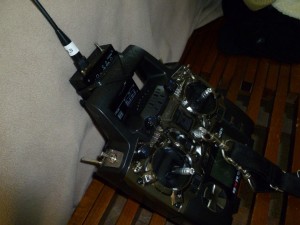There are several frequencies to choose for your RC transmitter and receiver by swapping “piggybacks” or “backpacks” onto your RC transmitter. For long range choose 443MHz. Be sure not to choose the same frequency that your video transmits on. I recommend 433MHz 500-800mW for RC and 1.3GHz 800mW for video long range and 900MHz for telemetry.. For short range; feel free to use 2.3-2.4GHz or 5.8GHz or really whatever you can get your hands on.
Here is a list of RC associated frequencies available:
27 & 35 & 72 MHz RC, These are low power “old style” transmitters. Short range; .2 to 2 mile est. These are radios that have been used in RC since the 1970’s. Don’t use these for anything other than park flying, because the controllers are low powered.
433MHz (UHF). LRS (long range system, RC community colloquialism). These LRS’s are only available as an add-on piggyback that mounts to the back of to your modern RC controller, like JR, Futaba, Spektrum or Turnigy. Signal travels through trees and buildings pretty well. On low end LRS’s an additional low pass filter may be necessary due to the 3rd harmonic: 433 x 3 = 1299MHz, use an SDR to check.
- Flytron OpenLRS – LRS 433MHz, 1W. 30-40 miles est. $145 for RCtx and RCrx, firmware upgradeable too.
- RangeLink – LRS 433MHz, 200/500mW. 30-40 miles est. $185 for RCtx and RCrx.
- Dragon Link – LRS 433MHz, 500mW. 30-40 miles est. $269 for RCtx and RCrx.
- ImmersionRC EzUHF – LRS 433MHz, 600mW. 30-40 miles est. $310 for RCtx and RCrx.
- Scherrer TSLRS – LRS 433MHz, 200mW to 8W boosters. 30-60 miles est. $450+ for RCtx and RCrx.
2.4GHz (2370-2450MHz) – Fly behind some objects. Lots of WiFi environmental interference. Typically 100-250mW. This is the standard that most RC transmitters feature internally. 2-4 miles est. To get more range, use a LRS add-on listed above and/or directional antenna, 15 miles est.
Turnigy 9XR with 433MHz Rangelink LRS “backpack”:


